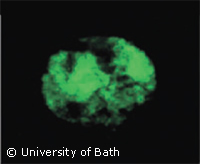New research shows how superbug spreads
Methicillin-resistant Staphylococcus aureus (MRSA) bacteria, the most lethal of the 'superbugs', uses amoebae to spread, according to researchers from the University of Bath in the UK. This has important implications for designing hospitals intended to prevent the spread of the disease. In their experimental research, Professor Mike Brown's team brought amoebae into contact with MRSA bacteria. Within 24 hours, half of the amoeba had succumbed to infection, while 2 per cent were found to be heavily infected. The research, published in the journal Environmental Biology, shows that the bacteria infect this very common, microscopic, single-celled creature. When the amoeba (Acanthamoeba Polyphaga) produces cysts in order to replicate, the MRSA bacteria goes with it. This method of transmission by-passes most of the barriers a hospital would erect in order to prevent MRSA spreading. 'Until now this source of MRSA had been totally unrecognised. This is a non-patient source of replication and given that amoeba and other protozoa are ubiquitous, including in hospitals, they are likely to contribute to the persistence of MRSA in the hospital environment,' said Professor Brown, from the University's Department of Pharmacology. Amoebae need water to live. Professor Brown believes that dry environments and the careful placing of sinks and other water sources will be crucial in reducing the spread of MRSA. 'I think we have to be very careful about any situation using water,' Professor Brown told CORDIS News. 'For example, if the sink is near the patient - there could be an aerosol effect of water droplets. It would not be a good idea for the patient to be near the sink. Anything containing water is a potential reservoir for amoebae and therefore MRSA,' he said. Other measures could include dehumidifiers or heaters to ensure a dry environment. Further research suggests that because the amoeba is infected first, this could make the MRSA bacteria more resistant to antibiotics when it does infect humans. 'It is almost as though the amoeba act like a gymnasium; helping MRSA get fitter and become more pathogenic,' said Professor Brown. The researcher believes that this method of infection transmission is extremely old, and that, 'many pathogens learned their pathogenicity after sparring with single-celled organisms like amoeba for millions of years. Because our human cells are very similar to these primitive, single-celled organisms, they have acquired the skills to attack us.' Primitive cells and protozoa such as amoeba have been identified as having so many similarities to human cells that some researchers now use them instead of animals for biological tests. Staphylococcus bacteria, of which MRSA is a type, is highly enigmatic. It infects the majority of adult humans, but with no symptoms. However, should Staphylococcus cause a deep infection, in the skin or blood, then it may cause meningitis, food poisoning, pneumonia and a series of other, possibly fatal, symptoms. In the elderly or infirm, MRSA has the ability to kill. There are more than 3,000 deaths from MRSA infections every year in the UK alone. 'Effective control of MRSA within healthcare environments requires better understanding of their ecology,' said Professor Brown. 'We now need to focus on improving our understanding of exactly how MRSA is transmitted, both in hospital and in the wilder environment, to develop control procedures that are effective in all scenarios,' he said.
Countries
United Kingdom



